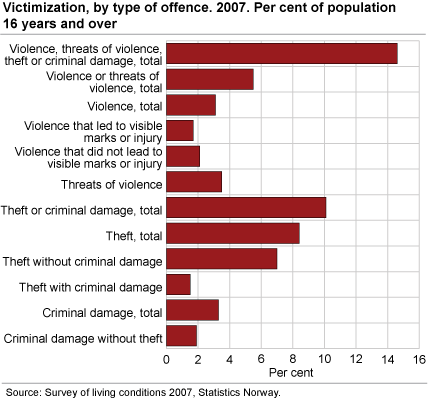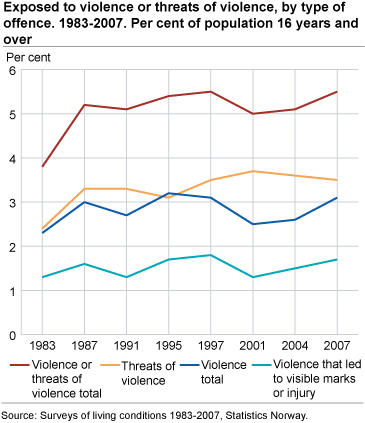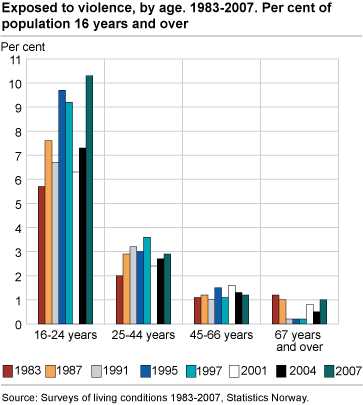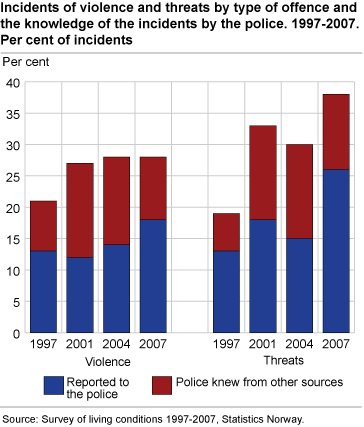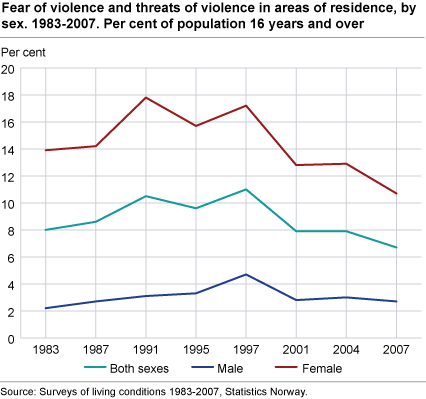Content
Published:
This is an archived release.
More violence and threats than theft
More youth report as exposed to violence, but in total there is no larger share of the adult population that is victim of offences. Fear of violence in areas of residence, together with concern for theft and criminal damage has become less prevalent.
The Survey of level of living 2007 shows that almost 15 per cent of the adult populaton in Norway was exposed to one or more incidents of violence, threats of violence or criminal damage during one year. 5.5 per cent was exposed to violence or threats of violence, and 10 per cent to theft or criminal damage (see figure).
Today a slightly larger share of the population is exposed to violence and threats of violence, and a slightly smaller share to theft and criminal damage, than reported in the survey in 2004. The share of the population exposed to violence and threats of violence is today as large as in the late 1990’s (see figure), but in 1997 13 per cent was exposed to theft or criminal damage.
More youth exposed to violence
As in 2004, more than every fourth juvenile (27 per cent) in the age 16-24 years are exposed to one or more offences each year. The increase in number of victims of violence and threats of violence, and the decrease in number of victims of theft, is however large amongst the youngest. In 2007 more than one out of ten juveniles were exposed to at least one incident of physical violence (see figure) and 14 per cent to theft against respectively 7 per cent and 17 per cent in 2004. The results of the Survey of level of living in 2007 show that more juveniles now experience becoming victims of violence and/or threats of violence than of theft, and among young men in the age 16-24 years, more than 14 per cent become exposed to physical violence during a year.
Male and female offenders on different arenas
In total, men are responsible for 80 per cent of all incidents of violence and threats. Offenders are men in most assaults towards victims under the age of 45 years. In addition, threats towards men and towards persons aged 45 years and over almost always have a male offender.
However, in the first Survey of linving where the offender’s sex and age is reported, one out of four incidents of violence involves a female offender. Females commit a particularly large share of the physical violence towards adults, in particular women, over 44 years of age and one fourth of all threats against the youngest victims in the age between 16 and 24 years (see figure). Violence towards women aged 45 and over is almost always committed by a person not influenced by alcohol or drugs, and the offender is in three of four incidents “client, patient or customer”. Threats towards young women happen however to a greater extent in private arenas and with offenders influenced by alcohol or drug.
In total, more than 40 per cent of all incidents of violence are committed by an offender under the age of 25 years, and the violence most often happens between two persons within the same generation. Young adults in the age 25-44 years are the offenders behind about half the threats towards both men and women, and towards the younger and older age groups.
Men and women are also exposed to different types of violence
The Survey of level of living 2007 shows, as do most previous surveys, clear differences in what types of violence men and women become victims of. Violence towards men is more often committed by an offender influenced by alcohol or drugs in public areas at weekends, and in half the violent incidents by an unknown offender. A much larger share of violent incidents towards women happens in residental areas, by offenders not influenced by alcohol or drugs. A relatively large share of all incidents of violence, both towards women (37 per cent) and men (29 per cent) happens at work where some labour groups have large shares of employees who often experience assault (see Survey of level of living, work environment )
Higher percentage of violence and threats reported to the police
Of all reported incidents of violence and threats of violence, the police have knowledge of 33 per cent. In 2001 and 2004 this share was 31 and 30 per cent respectively. In 2007, relatively large shares are stated to be reported: 18 per cent of violent incidents and 26 per cent of threats. In other words, the police seem to get to know more incidents, and compared to the two previous surveys a larger share of these seem to end up with a formal report to the police (see figure).
Less theft and criminal damage reported
In the Survey of level of living 2007, far more incidents of violence and threats of violence are reported than thefts, but in Norway private persons report far more thefts than violent offences to the police (see statistics on Offences reported to the police and Victims of offences, reported to the police ): In the Survey of level of living 2007, 22 per cent of all incidents of violence and threats of violence, and 53 per cent of all thefts and criminal damage, are stated to be reported to the police.
Four out of five thefts with criminal damage, which mainly happen to cars and residents, are reported to the police. The fact that this often reported type of theft makes a considerable smaller share of all theft than before (from 40 per cent in the Survey from 1991 to 17 per cent in the Survey from 2007) is one of the main reasons why the total percentage of reports has decreased from 74 per cent in 1991 to 57 per cent in 2007. The Survey however shows that the percentage reported also seemed to decrease for most types of theft and criminal damage.
Fewer women experience fear of violence in the areas of residence
Less than 11 per cent of women have in the last period before the Survey of level of living experienced situations where they have feared violence and threats of violence in their residential area, a considerably smaller share than in 1997 (more than 17 per cent, see figure). From being the clearly most tormented with fear for violence in their residential area up until the mid 1990’s, the share of women over 66 years of age who has experienced fear of violence is more than halved (from 25 per cent in 1997 to 11 per cent in 2007). It is today clearer than before, that fear of violence is more widespread among the youngest women, even if the share in this group has been reduced during the last years.
Fewer troubled by theft and criminal damage
In the last four surveys, the population has been asked if they in the last period have had fear of being exposed to theft or criminal damage. During these 11 years, the share of people who has experienced this has been more than halved, and today 10.5 per cent has been very or a little troubled by theft or criminal damage.
More results from the Survey of level of living 1983-2007, victimization and fear of crime are available in StatBank Norway .
Find more figures
Find detailed figures from Victimisation and fear of crime, survey on living conditions
Additional information
Read more about the execution of the last survey in the documentation note (Norwegian only):
Contact
-
Reid Jone Stene
E-mail: reid.jone.stene@ssb.no
tel.: (+47) 99 02 22 01

